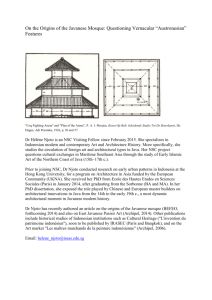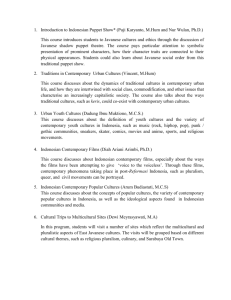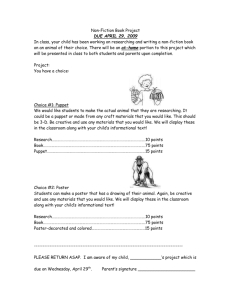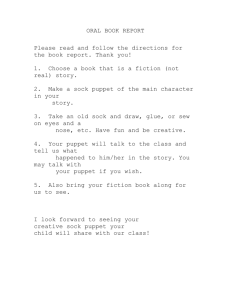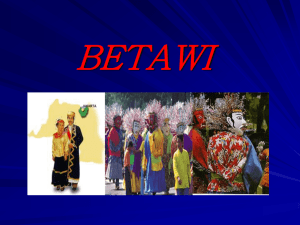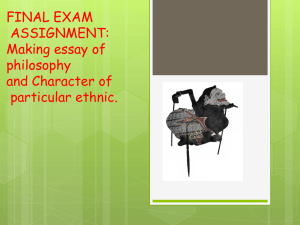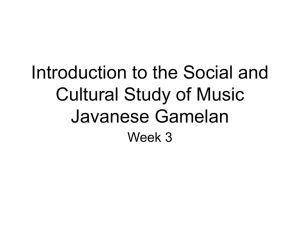Theatre as Media| LANGUAGE AND POWER: THE ISSUES OF
advertisement
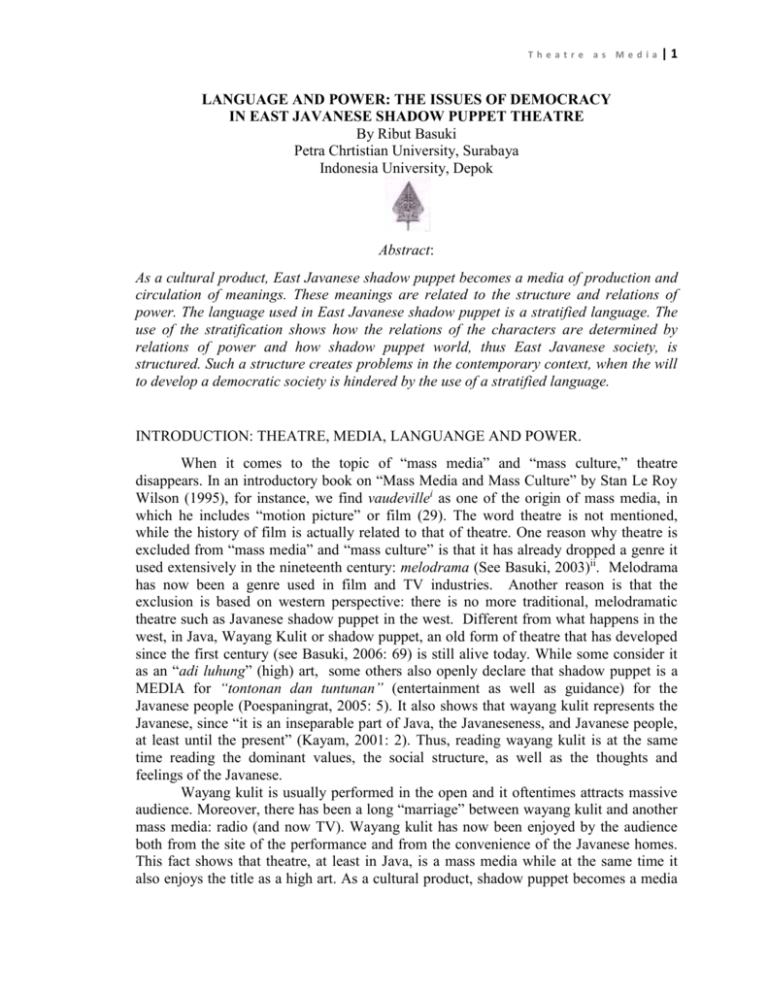
Theatre as Media |1 LANGUAGE AND POWER: THE ISSUES OF DEMOCRACY IN EAST JAVANESE SHADOW PUPPET THEATRE By Ribut Basuki Petra Chrtistian University, Surabaya Indonesia University, Depok Abstract: As a cultural product, East Javanese shadow puppet becomes a media of production and circulation of meanings. These meanings are related to the structure and relations of power. The language used in East Javanese shadow puppet is a stratified language. The use of the stratification shows how the relations of the characters are determined by relations of power and how shadow puppet world, thus East Javanese society, is structured. Such a structure creates problems in the contemporary context, when the will to develop a democratic society is hindered by the use of a stratified language. INTRODUCTION: THEATRE, MEDIA, LANGUANGE AND POWER. When it comes to the topic of “mass media” and “mass culture,” theatre disappears. In an introductory book on “Mass Media and Mass Culture” by Stan Le Roy Wilson (1995), for instance, we find vaudevillei as one of the origin of mass media, in which he includes “motion picture” or film (29). The word theatre is not mentioned, while the history of film is actually related to that of theatre. One reason why theatre is excluded from “mass media” and “mass culture” is that it has already dropped a genre it used extensively in the nineteenth century: melodrama (See Basuki, 2003)ii. Melodrama has now been a genre used in film and TV industries. Another reason is that the exclusion is based on western perspective: there is no more traditional, melodramatic theatre such as Javanese shadow puppet in the west. Different from what happens in the west, in Java, Wayang Kulit or shadow puppet, an old form of theatre that has developed since the first century (see Basuki, 2006: 69) is still alive today. While some consider it as an “adi luhung” (high) art, some others also openly declare that shadow puppet is a MEDIA for “tontonan dan tuntunan” (entertainment as well as guidance) for the Javanese people (Poespaningrat, 2005: 5). It also shows that wayang kulit represents the Javanese, since “it is an inseparable part of Java, the Javaneseness, and Javanese people, at least until the present” (Kayam, 2001: 2). Thus, reading wayang kulit is at the same time reading the dominant values, the social structure, as well as the thoughts and feelings of the Javanese. Wayang kulit is usually performed in the open and it oftentimes attracts massive audience. Moreover, there has been a long “marriage” between wayang kulit and another mass media: radio (and now TV). Wayang kulit has now been enjoyed by the audience both from the site of the performance and from the convenience of the Javanese homes. This fact shows that theatre, at least in Java, is a mass media while at the same time it also enjoys the title as a high art. As a cultural product, shadow puppet becomes a media Theatre as Media |2 for “the production and circulation of meanings” (Giles and Middleton, 1999: 25) as well as a “place in constructing, sustaining and reproducing structures and relations of power” (ibid., 25). This is due to the fact that meanings are internalized by subjects as knowledge which is, in Foucauldian sense, always related to power (see Foucault, 2002). Javanese shadow puppet may be discussed from a variety of aspects such as the music, the puppets as fine arts, the songs, etc. In this paper I will focus on an aspect related to language—the dialogs. I select this aspect since from the ginem (dialog), thus from the language of shadow puppet, we can see clearly how relations of power operate. Thomas and Wearing (2007) suggest that there are fouriii functions of language, two of which are related to power. The two functions related to power are referential and affective. Referential function of language is related to the terms used to address an object or idea and how to describe an event (in other words, how we represent the world around us and the consequences of the representation to the way we think, . . ). Affective function is related to who “has the right” to say what, which is related to power and social status. (14) Using the two functions of language, meanings related to power are produced and circulated. This paper, therefore, pays attention to how Javanese (language) reveals “structures and relations of power” in Javanese shadow puppet. Owing to the limitation of space given, this paper deals only with the problems related to language stratification in the Javanese language. To do so, I will analyze an East Javanese shadow puppet audiorecorded text, Rabine Narasoma by Ki Suparno Hadi (2007). LANGUAGE AND POWER: THE ISSUES OF DEMOCRACY IN EAST JAVANESE SHADOW PUPPET THEATRE In an article entitled “Demokrasi ‘Krama inggil,’” Satjipto Rahardjo discusses the relationship between Javanese (language) and demonstrations (Kompas, August 22, 2007). Rahardjo sees, “Demonstrasi sekarang boleh disebut sebagai demonstrasi ‘ngoko,’ sedangkan di masa kerajaan dulu disebut ‘demonstrasi krama inggil’” (39). He calls demonstrations today as ngoko since people use rough language and they tend to be destructive, unlike what people did in the past by the action of pepeiv, a polite demonstration. What is interesting in this article is that demonstration is related to the Javanese language which represents Javanese social hierarchy, something that is represented well by the world of shadow puppet. In Javanese shadow puppet, dialog is done in Javanese language which has a very complicated stratification of styles. In general, as stated by Rahardjo, the language has three levels, namely ngoko, krama madya, and krama inggil. Ngoko is the everyday language for people of the same age and social status, especially in the lower class. Ngoko is also used by older to younger people or by people of a higher to a lower status. Krama madya is used by younger people to older ones or by people of a lower to a higher status, especially in the middle class or lower. Krama inggil, the finest style, is used by younger people to older ones, or by lower class to higher class people, or by people of the same class (higher class). A person’s ability to use krama inggil indicates his/her gentle and noble attitudes, especially if s/he wants to be considered as “cultured” by the society. All the styles, together with the “court style”, are used in shadow puppet performances. This language use shows power relations among characters in shadow puppet universe, including Rabine Narasoma by Ki Suparno Hadi. Theatre as Media |3 Rabine Narasoma stages Mandaraka kingdom, in which king Mandraspati is stepping down and should be replaced by his son, Narasoma. Narasoma, however, feels that he is not ready and he wants to get knowledge by having a journey. In his journey, he meets a giant priest called Bagaspati, whose daughter wants to be Narasoma’s wife. Looking at Bagaspati’s appearance, Narasoma rejects the priest’s proposal. Yet, after seeing the priest’s daughter, Gandawati/Pujawati, who is beautiful, he is willing to take her as his wife on condition that Bagaspati should die. Narasoma does not want to have a giant father in law. For his daughter’s sake, Bagaspati accepts the condition. He even gives his magic spell, Cendabirawa, to Narasoma so that he becomes a powerful king in the future. The dialog in jejer Mandaraka shows the complex relations among characters by the language the characters use. In the opening dialog, king Mandraspati uses ngoko to patihv Tuhayata, while Tuhayata uses krama inggil. MANDRASPATI: . . . Tuhayata. TUHAYATA : Nun inggih, sinuwun, gusti, kang abdi pun patih Tuhayata ngaturaken sembahing pangabekti mugi konjuk wonten ing sahandap pepadanipun gusti kula ing Mandaraka . . . MANDRASPATI: Ingsun tampa, yayi. Wus tak trima sembah sungkem para, ora liwat pangestune pun kakang tampanana, Tuhayata. (Cass. 1) After the opening dialog, Mandraspati uses more informal ngoko with a stronger etanan (eastern) dialect: MANDRASPATI: . . . Penggedhe-penggedhe ana ing Mandaraka kene tambah njengkelna atiku, saya suwe nyepet-nyepeti mripat. . . . Apa pantes, pejabate ae mbois-mbois, tur klemis-klemis, pakeane necis-necis, tapi rakyate akeh sing dadi tukang ngemis. Kaya ngono iku apa pantes, Tuhayata? (Cass. 1) On the other hand, Tuhayata still uses the formal krama inggil. This use of different styles is common in Javanese culture; it is perfect in terms of “unggah-ungguhing basa” (manner in using language). Mandraspati’s use of ngoko is acceptable since in terms of status (he is the highest leader in the kingdom) and age (he calls Tuhayata yayi/younger brother) he should be more respected. When taking to patih (of internal affairs) Sungkawa Reksa, who is older than the king, Mandraspati also uses ngoko, while the patih uses krama inggil: MANDRASPATI: Paman patih Sungkawa Reksa, kaya apa paman, Negara Mandaraka lan penggedhe-penggedhene, kok angel tatan-tatanane. SUNGKAWA REKSA: Aduh sinuwun, nun inggih gusti. Kula nyuwun pangapunten, mekaten duh sinuwun, awit kula menika, pakaryan kula wonten lebet. . . . yen ing njawi wonten kahanan ingkang mekaten, ingkang mboten ngeremanken, sinuwun, . . . menika sanes pakaryanipun ingkang abdi (Cass. 1). It shows that in the context of Javanese culture, status comes before age. Even though Sungkawa Reksa is older, he should use krama inggil since in terms of status he is lower. On the other hand, Mandraspati can only use ngoko. Yet, when talking with Begawan Mangkurat Jati, who is the king’s father, both Mandraspati and his father use krama inggil. MANDRASPATI: Rama penembahan, Rama, kula nyuwun kanjeng rama menika Theatre as Media |4 paring wawasan, kawontenanipun ingkang putra bab mengku pusaraning adil wonten ing nagari Mandaraka ingkang kados menika rama. . . . MANGKURAT JATI: Anak angger, anak angger prabu. Nuwun sewu nggih ngger, awrat ngger anggen kula matur wonten in ngerso penjengangan anak angger, inggih yen ketampi, yen mboten. Mbok menawi menika mengke malah nambahi sungkawanipun batin paduka. Mekaten anak prabu. (Cass. 2) The difference between Sungkawa Reksa and Mangkurat Jati before Mandraspati is in their relations outside structural relations of the kingdom. As the father of the king, Mangkurat Jati is of the same social status with him. It is only common, therefore, that the king uses krama inggil to Mangkurat Jati. The use of krama inggil here is similar to that, for example, by Puntadewa and Kresna in Amarta or by Duryudana and Baladewa in Astina. In such relations, they use krama inggil, which shows mutual respect. Sungkawa Reksa, in contrast, comes from a lower social status so that, although he is older, he should use krama inggil to the king and accept ngoko in return. The use of ngoko-ngoko happens in the dialog between the tumenggungs (counts) when they are permitted to talk by the king: BAUREKSA : (To Mandraspati) Nuwun sewu sinuwun. Nadyan negara menika ketingal makmur, tanahe gembur mawur-mawur, kenek napa kok ekonomine rakyat kok ajur, nuwun sewu sinuwun, mergane wong Mandaraka niku akeh sing doyan mlacur. Lho. Ngoten lho. JAYA TOHPATI: Heh kang, kakang. BAUREKSA : Apa dhi. JAYA TOHPATI: Rika aja angger ngomong kakang. Padha karo mbukak kertuning kancane dhewe, ngerti? Aja sok sumuci-suci. Apa rika ya ora nglakoni kaya ngono? BAUREKSA : Ho ho ho. Ha nek budhal ya bareng karo awakmu ngono. (Cass. 1) vi The use of ngoko by Baureksa and his friend above feels very etanan , but it is still within the “undha-usuk” (linguistic manner). To Mandraspati, Baureksa uses krama inggil although he puts some etanan ngoko words. Yet the mix of krama inggil and ngoko by Baureksa is acceptable since he is characterized as a selengekan/comic count, similar to Dursasana of Astina or Pragota of Dwarawati. The use of ngoko-ngoko is clearer in the dialogs of panakawan, lower class people below: SEMAR : Gong. BAGONG: Apa ma? SEMAR : Heh. Suaramu glorok-glorok nak. BAGONG: Asuarane glorok-glorok. BESUT : Ya pak dhe, nyuwuna pangapura. (Cass. 4). We can see that ngoko-ngoko is used by lower nobility (thus middle class) such as Baureksa and lower class characters such as Semar, Bagong and Besut. Thus, it is clear that the use of language styles in Rabine Narasoma shows the social structure of the wayang or Javanese society. There is, however, an interesting case in linguistic relations between kaum satria (nobility) and brahmana (priest), with a distinctive difference between those in the court meeting in Mandaraka and those in the hermitage Gebangkara Winangun, where hermit Theatre as Media |5 priest Bagaspati lives. While in the court meeting both king Mandraspati and priest Mangkurat Jati use krama inggil, in the hermitage, priest Bagaspati uses ngoko while his guest, Kunta Warangpati—king of Mahandrapura, uses krama inggil: BAGASPATI: . . . Sliramu ini ratu saka ngendi, lan sapa sing dadi asmamu, sang prabu . . . KUNTA WARANGPATI: . . . keparenga kula badhe matur wonten ngersa penjenengan . . . (Cass. 6) It may give an impression that since Kunta Warangpati is a guest, he is the one to use krama inggil. Yet, when Bagaspati meets Narasoma, prince of Mandaraka, who is still very young, the reverse happens: NARASOMA: Sang penembahan, penjenengan iki sapa? BAGASPATI: Inggih den. Kula menika . . . Begawan Gundhawijaya, inggih Begawan Bagaspati. . . . Kula saking pertapan Gebang Wara Winangun, ngaten gus. Penjenengan menika sinten nggih den. NARASOMA: Aku putra mandaraka. Raden Narasoma jenengku, sang penembahan. (Cass. 6) The difference between Bagaspati-Kunta Warangpati’s encounter and that of BagaspatiNarasoma is that while Kunta Warangpati comes to be Bagaspati’s student, Narasoma is to be found by Bagaspati to marry his daughter. On first reading, from such a difference we may conclude that the use of krama-ngoko in the text is based on interest. Since in the first case it is Kunta Warangpati who needs Bagaspati, he should use krama and Bagaspati can use ngoko. In the second case, since it is Bagaspati who needs Narasoma, Bagaspati should use krama and Narasoma use ngoko. Yet, if we pay attention to the scene, we will discover that the use of ngoko by Bagaspati to Kunta Warangpati is related to the “message” that will be delivered by the dalang. Bagaspati in this text is characterized like a kiai (a Moslem religious leader), both physically and linguistically. Bagaspati is a giant priest who wears “sorban.”vii Listening to Bagaspati, I imagine I am listening to a kiai of an Arabic descent giving a sermon in a mosque: BAGASPATI: . . . Lha wong tani saiki ki, panen zakate gak kopen, akeh pedagang nek nawakna barang, ndugang. Sing mlarat-mlarat gak kuat tirakat, senengane pada tombok togel. Lho ya. Tapi ana kene gak onok . ................................................... Morale didandani, menungsane cek gak ndugal, nom-nomane cek gak metal, pejabate cek gak brutal, nek pejabate brutal sembarang doyan. Bah iku aspal, bah iku koral, masia numpuk sak kapal, diuntal. Lho. . . . (Cass. 6). Such kind of sermon is more effective when delivered in ngoko style, more over, as a religious leader a kiai has a higher status than his followers. Thus, the choice of ngoko by Bagaspati is for the sake of the contextualization of the performance, not to disagree with Javanese linguistic manner. In contrast, when he meets Narasoma, Bagaspati becomes a shadow puppet character again, not a kiai anymore. As a shadow puppet character this “rural” hermit priest uses krama inggil to Narasoma, a nobility from Mandraspati kingdom. All the linguistic usages in the text, therefore, show more or less standard relations between the king and the subjects around him. The king, the highest leader, gets the highest respect by being addressed in krama inggil, even by his own father. On the Theatre as Media |6 other hand, the king has the freedom to use language styles. He uses krama inggil only to Mangkurat Jati, his father, while to the others he uses ngoko. Only in a certain case, such as in Bagaspati’s dialog, ngoko is chosen for the sake of the sermon so that it becomes more effective. The text shows how language represents structure of power, from the highest to the lowest, and how relations of characters are structured based on power relations. The text has shown that the highest leader in Javanese culture can use ngoko to his subordinates, younger or older. Thus, more than just a social politeness, Javanese language stratification also shows political relations. It means that Javanese social structure is determined by power structure. Moedjanto (1984) even traces this matter and finds that “the development of ngoko-krama is a way to strengthen Mataram dynasty as a dynasty of Javanese power holder. Therefore, ngoko-krama stratifications was deliberately developed, so that it becomes complicated, as a political means . . . “ (45). Moedjanto believes that the development of ngoko-krama stratification started in Mataram era under Sultan Agung (1613-1645 AD) (46-55). If this is true, it means that the language in Javanese shadow puppet is the reproduction of that since Mataram era, which means that the discourse of power in Javanese shadow puppet is a feudalistic discourse from the antiquity. “Language is a means to articulate power” (Haryatmoko, 2003: 225), and Javanese language articulates feudalistic power since Mataram kingdom. Nowadays, the issues of democracy may be brought to a performance. Using Narasoma’s words, Ki Suparno Hadi tries to give democratic nuance in his performance when Narasoma says, “. . . kula purun dados ratu menawi dipilih kaliyan rakyat” [. . . I am willing to be a king if I am elected by the people] (Cass. 2). Yet, Ki Suparno Hadi cannot escape from the monarchy in shadow puppet story so that he cannot explore more. A bolder effort was once tried in another performance by Ki Hari Bawono (2003) entitled Petruk Nagih Janji. When the children of Pandawa, Anoman, and Petruk want to decide who should be Amarta’s temporary king since Puntadewa, the real king, leaves the throne, they try to do it “democratically.” The democracy, however, is not determined by votes, but by supernatural power. The candidates are tested by wearing sumping purba kayun, an ear ornament, and the winner is Petruk, the panakawanviii. A problem which cannot be solved by the supernatural power, then, is the language among characters as they now have different relations of power. This is because Javanese language has already been structured in stratifications based on social status and age. When the relations change, therefore, Javanese language becomes troublesome. Talking to “king” Petruk, Anoman is confused: ANOMAN: Menawi . . . menawi koweix . . . PETRUK : Pendhita kok kaya telek ngene. “Menawi kowe” ki lho apa. ANOMAN: … kenek ratu ngene ki jan bingung aku ki . . . (Cass. 5) [ANOMAN: If . . . if kowe. . . PETRUK : What kind of priest are you? Like a rotten shit. What is “if kowe”? ANOMAN: I’m really confused talking to this kind of king] (Cass. 5) Owing to such difficulties, a lot of Javanese now use Indonesian. In reality there has been a lot of social status permutations in Java so that some people get confused when using Javanese undha usuk or linguistic manner. At this point, Javanese people prefer to use Indonesian as a formal language, leaving Javanese language in informal and ritual Theatre as Media |7 spheres. What needs to be considered is, however, how much influence the informal sphere gives to the formal spheres of Indonesian nationhood and democracy, and whether the influence is positive of negative. Satjipta Rahardjo said that in delivering their opinion, people should be polite. We need to question whether people should use stratified language like Javanese to be polite. Other cultures have their own languages, most of them do not have stratifications. Some people in those cultures are polite, some otherwise. It means that politeness in stating an opinion is not determined by language stratification, but by the attitude of respecting others. Language stratification, on the other hand, even creates problems since societies today change quickly and social status my change every moment. In such a condition, more and more people will experience difficulties in using language styles such as in the case of Petruk and Anoman. There has been a lot of experts who reveal the beauty and goodness of Javanese cultural values. However, Javanese culture also has its own weaknesses, especially in developing a modern, egalitarian society. On the aspect of language, this has been forwarded by Suko Widodo when, in a Javanese culture seminar in Surabaya, he said that “the communication codes of Javanese language has been outdated” (Kompas, January 29, 2008). This is due to the fact that the communication codes are the residues of the feudalistic ones reproduced since Mataram kingdom. The modern Javanese language, therefore, is still loaded with the old feudalistic values. In Surabaya, there has been a curious phenomenon lately, when Dinas Pendidikan (Education Bureau) Surabaya suggests that schools implement “hari wajib bahasa Jawa” [Compulsory Javanese language day]. There has been discourses on this matter, both pro and contra. A lot of people agree, with an idea that using the language will improve students’ manner and politeness (Kompas, Pebruary 2, 2008). The opposing discourses, on the other hand, question the difficulty in its implementation since Javanese language in Surabaya varies (kulonan/western or etanan/eastern dialects), and Surabaya is a multiethnic city. “Which dialect is to be implemented, the mentaraman pakem, which is ethically feudalistic and mriyayeni,x or the egalitarian Surabaya sub-dialect?” asks Beni Setia (2008). Thus, the Javanese people themselves see that Javanese language has problems, and the main problem is between maintaining the feudalistic language or developing a more egalitarian one. In fact, as the text discussed in this paper shows, the etanan dialect is also stratified. It means that it is not yet as egalitarian as many Javanese would expect. If we agree with Komaruddin Hidayat who feels sorry for “the society’s attitude in looking back too much to the past [so that] unconsciously they forget about how to survive in the global competition” (Kompas, August 29, 2007), Javanese society needs to think about having a more egalitarian language, for example, by using ngoko and ngoko andhapxi as a formal language. Otherwise, people will use Javanese in informal spheres and they “code switch” to Indonesian in formal ones as they do now. CONCLUSION Shadow puppet is a cultural product like any other products such as jail or hospital. It reminds us, therefore, of Foucault’s analysis of the two in Discipline and Punish (1977). Foucault discusses, among others, how “jail” and “criminal” are the products of a long process, and their meanings change based on power/knowledge relations among subjects: officials, the police, lawyers, even psychologists who deal with Theatre as Media |8 them. “Shadow puppet” and “dalang,”xii likewise, are also the products of power/knowledge relations. If the power/knowledge relations in “jail” and “criminal” are not necessarily negative, except that there is domination of meanings by the more powerful, so are those related to shadow puppet. Since there have been a lot of interests from subjects related to shadow puppet, the power relations are always complicated. Thus, Javanese language with its stratifications remains alive in shadow puppet due to power relations within it. One way or another, people in power enjoy respects given to them. Shadow puppet is a good media to maintain people’s respect to their leaders since it puts the powerful (kings, nobility, priests, etc.) in special and respected places. This is one reason why a lot of government officials like to engage in shadow puppet to celebrate their special occasions. On the other hand, these official are promising ‘market’ for dalangs. Such a relation, in turn, keeps shadow puppet alive and productive both economically as well as culturally. A performance by Ki Hari Bawono staging Petruk Nagih Janji mentioned previously can be a good example for such mutually beneficial relations. His performance was for the anniversary of BK3Sxiii and the inauguration of Governor Imam Utomo in 2003. Using panakawan’s dialog (Cangik and Limbuk), the dalang says: . . . kelungguhan iki, aku kelawan kowe, ana keparenge penggalih para pepundhen-pepunden kulawarga ageng BK3S ing kalungguhan iki, supaya aku Nyangik . . . Ingkang sepisan, ujube keluarga agung BK3S iki ambal warsa ingkang kaping patlikur ya nduk. . . . Dene ingkan angka loro nduk, mahargya dina ambal warsa kamardikane bangsa Indonesia ingkang kaping seket wolu. . . . Dene ingkang angka telu nduk, . . . ngaturake puji syukur marang Gusti ingkang akarya jagad, awit saking keparengipun kawisuda malih penjenenganipun bapak ingkang pikantuking pakurmatan bapak Imam Utomo minangka dados Gubernur Jawa Timur periode 2003-2008, sarimbit kaliyan bapak Sunaryoxiv. (2003:Cass. 2) . . . right now, you and I, there is a generosity of our respected patrons the BK3S big family right now, in oder I play as Cangik. . . . Fisr of all, this is the twenty fourth anniversary of BK3S big family, my daughter. . . . while secondly, my daughter, this is the fifty eights anniversary of Indonesian people’s freedom . . . while thirdly, my daughter, . . . we thank God the Almighty, since from His will the respected Mr. Imam Utomo is inaugurated again as the Governor of East java for 2003-2008 period, together with Mr. Sunaryo (2003: Cass. 2) With such “mutually beneficial” relation of government official or political leader-dalang, it is understandable why shadow puppet survives until today and stratified Javanese language still finds its cultural context: feudalistic democracy. Power relations in wayang kulit show how every subject may benefit from it. REFERENCES: Bawono, H. (2003) Petruk nagih janji. Kaset 1-7, Koleksi Radio Pertanian Wonocolo (RPW/ dulu RKIP), Wonocolo-Surabaya. “’Basa’ jawa di sekolah.” Kompas, Sabtu, 2 Pebruari, 2008. Hal. D. Theatre as Media |9 Basuki, Ribut. (2003). “A journey across the Atlantic: The history of melodrama in western landscape.” K@ta Journal. Vol. . . . -----. (2006). “Panakawan’s discourse of power in Javanese shadow puppet during the new order regime: from traditional perspective to new historicism.” K@ta Journal. Vol. 8/No. 1. Pp. 68-87. Foucault, M. (1977) Discipline and Punish. London: Penguin. ---------- (2002) Power/Knowledge: Wacana kuasa/pengetahuan. Terj. Y. Santosa. Jogjakarta: Bentang Budaya. Giles, J & T. Middleton (1999) Studying Culture: A practical introduction. Massachusetts: Blackwell Publication. Haryatmoko. (2003) Etika politik dan kekuasaan. Jakarta: Kompas. “Kode komunikasi bahasa Jawa sudah ketinggalan zaman: Pelajaran bahasa Jawa terlalu condong ke Jawa Tengah” Kompas. Selasa, 29 Januari, 2008. Hal. J. Kayam, U. (2001) Kelir Tanpa Batas. Yogyakarta: Gama Media. Moedjanto, G. (1987) Konsep kekuasaan jawa: Penerapannya oleh raja-raja Mataram. Yogyakarta: Kanisius. Rahardjo, S.,(2007) “Demonstrasi ‘krama inggil’”, Kompas, 22 Agustus. Hal. 39. Setia, Beni. (2008) “Kegagapan hari berbahasa Jawa.” Kompas, Senin, 11 Pebruari, 2008. Hal. H. “Sulit jadi bangsa besar: Masih transisi dari masyarakat agraris ke modern”. Kompas, Rabu, 29 Agustus, 2007. Hal. 4. Poespaningrat, R.M. P. (2005). Nonton wayang dari berbagai pakeliran. Yogyakarta: Kedaulatan Rakyat. Thomas & Wareing (2007) Bahasa, masyarakat, & kekuasaan. Trans. Languange, society and power. Yogyakarta: Pustaka Pelajar. Wilson, Stan Le Roy. (1995). Mass media/mass culture: An introduction. 3rd Ed. New York: McGraw-Hill. i “ . . . a popular form of entertainment in the nineteenth century. Vaudeville took the traditional forms of popular entertainment or folk art, such as ethnic humor, juggling, dancing and clown acts, and made them part of the new mass culture” (Wilson, 1995: 29). ii In this article, among others, I discuss how in the U.S. melodrama moves from theatre to film. iii They mention referential, affective, aesthetic (such as in poetry), and phatic (as social lubricant such as in small talks). iv It is a form of protest done by people in the past (kingdoms) in the form of standing under the sun in front of the palaces. v More or less like prime minister or “vice king”. vi Eastern dialect, a dialect that is quite remote from the influence of Javanese kingdoms (Yogyakarta and Surakarta). vii Sorban is a kind of head band usually worn by Moslem religious leader. I also went to the performance, so whenever I listen to the recorded text I always remember his appearance. viii A clown who represents common people. ix The literal translation is “If . . . if you . . .” In this dialog, the audience laugh. In the translation, however, we cannot see the joke since English does not have stratification. x Doing the manner of the priyayi, the Javanese nobility. xi A sub-from of ngoko with the combination of ngoko style and krama words. xii Shadow puppet player/artist. Theatre as Media xiii | 10 Stands for Badan Koordinasi Kesehatan dan Kesejahteraan Sosial (Health and Social Welfare Coordinating Bureau), headed by Mrs. Imam Utomo. xiv Vice governor.
